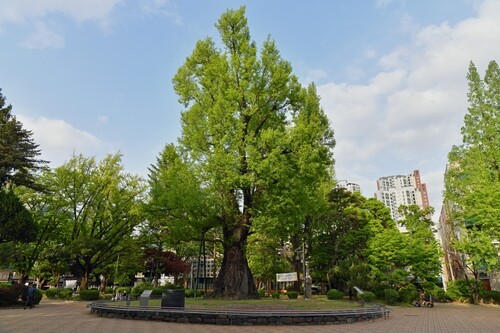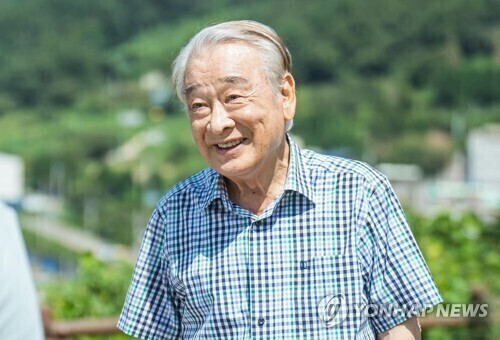 |
| ▲ This photo provided by the Korea Heritage Service shows the ginkgo tree that has stood guard over Cheongju in North Chungcheong Province for more than 900 years, set to be designated a natural monument. (PHOTO NOT FOR SALE) (Yonhap) |
SEOUL,
Nov. 26 (Yonhap) --
According to the Korea Heritage Service on Wednesday, the Natural Heritage Committee’s subcommittee on fauna and flora recently reviewed and approved a proposal to designate the “Cheongju Apgak Tree” as a natural monument.
The Cheongju Apgak Tree refers to a ginkgo tree located in Jungang Park in downtown Cheongju. “Apgak tree” is one of the names used for ginkgo trees.
The tree is estimated to be about 900 years old. It stands 23.5 meters tall, with a trunk circumference of 8.5 meters measured at about 1.2 meters above ground. Despite its great age, it still turns a brilliant yellow each autumn.
The tree is considered historically significant. An anecdote related to the late Goryeo Dynasty loyalist and renowned scholar Yi Saek (1328–1396), also known by his pen name Mogeun, is recorded in the early Joseon Dynasty geographical text “Dongguk Yeoji Seungnam.”
In 1390, military officials Yun Yi and Yi Cho falsely accused Yi Seong-gye — later King Taejo of Joseon (r. 1392–1398) — and his faction of plotting an invasion of China’s Ming Dynasty. As a result, Yi Saek and several other scholars were imprisoned in what later became known as the Yi Cho incident.
According to the story, “Yi Saek and about 10 other virtuous officials were unjustly imprisoned in a Cheongju jail, but when a massive flood struck, they climbed the Apgak tree and escaped harm.”
Upon hearing the news, the king is said to have interpreted their survival as Heaven’s proof of their innocence and ordered their release.
The ginkgo tree also appears in various historical documents and on old maps, including depictions in the “Cheongju Eupseong” map.
The Cheongju Apgak Tree is believed to hold unique value even among other ginkgo trees. As of October this year, a total of 25 ginkgo trees — including those at Seoul’s Munmyo Shrine, Yongmunsa Temple in Yangpyeong, Gyeonggi Province, and Bangye-ri in Wonju, Gangwon Province — have been designated natural monuments.
An expert who took part in the designation survey said, “The tree has sufficient historical evidence and value,” adding, “It is also noteworthy that among the many names for ginkgo trees, only this one has continuously been called ‘Apgak Tree.’”
The Korea Heritage Service plans to officially announce the designation of the Cheongju Apgak Tree as a natural monument through the government gazette after completing internal procedures.
(C) Yonhap News Agency. All Rights Reserved

















![[가요소식] 스키즈, 브라질 음악축제 '록 인 리오' 헤드라이너](https://korean-vibe.com/news/data/20251126/yna1065624915937039_143.jpg)





